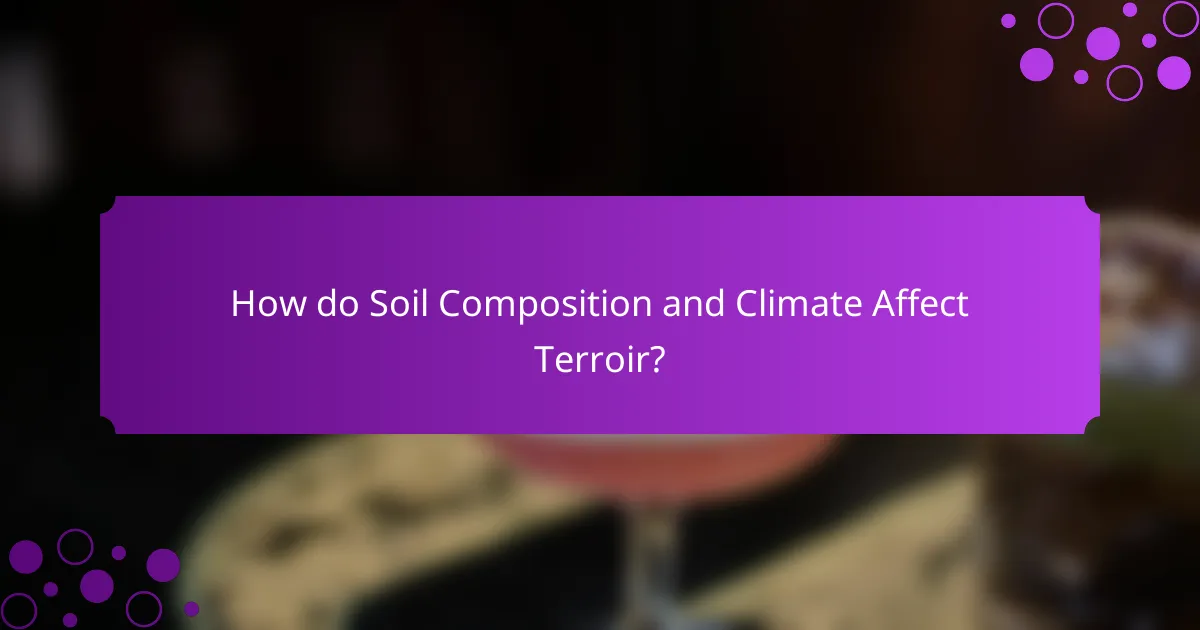
What is the Role of Terroir in Aging Potential of Limited Edition Wine?
Terroir significantly influences the aging potential of limited edition wine. Terroir encompasses soil composition, climate, and grape variety. Each of these factors contributes to the wine’s unique characteristics. For instance, specific soil types can enhance mineral content in grapes. This mineral content often leads to improved flavor complexity over time. Additionally, climate affects the ripening process of grapes. Grapes from cooler climates typically develop higher acidity, which supports aging. The grape variety also plays a crucial role in aging potential. Certain varieties are naturally more resilient to oxidation, allowing them to age gracefully. Overall, the interplay of terroir elements determines how well a wine can mature and develop its flavors.
How does terroir influence the characteristics of wine?
Terroir significantly influences the characteristics of wine through its unique combination of soil, climate, and grape variety. Soil composition affects drainage, nutrient availability, and mineral content, which directly impact vine health and grape flavor. Climate determines temperature, sunlight, and rainfall, influencing the ripening process and sugar levels in grapes. Different grape varieties express distinct traits based on their adaptation to specific terroirs. For example, Pinot Noir thrives in cooler climates, producing lighter, fruit-forward wines. Research shows that wines from the same grape variety can taste remarkably different when grown in varying terroirs, highlighting the importance of location. The interplay of these factors shapes the aroma, flavor, and aging potential of the wine, creating a unique profile for each bottle.
What are the key components of terroir?
The key components of terroir include soil composition, climate, and grape variety. Soil composition affects drainage, nutrients, and mineral content, influencing vine health and grape quality. Climate encompasses temperature, rainfall, and sunlight, which determine the growing season and grape ripeness. Grape variety refers to the specific type of grape, which contributes distinct flavors and characteristics. Together, these components create a unique environment that shapes the wine’s flavor profile and aging potential.
How do soil types affect wine aging?
Soil types significantly affect wine aging by influencing drainage, nutrient availability, and temperature regulation. Different soil compositions, such as clay, sand, and limestone, impact the vine’s root system. For example, clay retains moisture, promoting slower ripening. This can enhance flavor complexity in the resulting wine. Sandy soils drain well, leading to lower yields but concentrated flavors. Limestone enhances acidity, which is crucial for aging potential. Research shows that wines from limestone-rich regions often age longer due to balanced acidity and minerality. Thus, soil type directly correlates with the aging process and overall wine quality.
Why is aging potential important for limited edition wines?
Aging potential is crucial for limited edition wines because it enhances their complexity and value over time. Limited edition wines are often produced in small quantities, making their aging characteristics significant for collectors and connoisseurs. Wines with high aging potential can develop intricate flavors and aromas as they mature, which increases their desirability. For instance, wines from renowned regions like Bordeaux or Burgundy are known for their aging potential, often improving for decades. This maturation process can lead to greater market appreciation and higher resale prices. Additionally, limited edition wines often come from exceptional terroirs, where soil composition, climate, and grape variety contribute to their ability to age gracefully.
What factors contribute to the aging potential of wine?
The aging potential of wine is influenced by several key factors. These include grape variety, acidity, tannin levels, and alcohol content. Grape variety determines the inherent qualities and structure of the wine. High acidity helps preserve wine over time, allowing it to age gracefully. Tannins, which come from grape skins and seeds, contribute to the wine’s structure and longevity. Elevated alcohol content can also enhance aging potential by acting as a preservative. Additionally, the terroir, which encompasses soil composition and climate, plays a crucial role in shaping these attributes. For instance, well-drained soils can lead to healthier vines, while specific climate conditions can enhance the concentration of flavors in the grapes.
How does aging impact the flavor profile of limited edition wines?
Aging significantly enhances the flavor profile of limited edition wines. As wine ages, chemical reactions occur that develop complex flavors. Tannins soften, leading to a smoother mouthfeel. Fruit flavors evolve, often transitioning from fresh and vibrant to more subtle and nuanced. Secondary flavors such as earthiness, spice, and floral notes may emerge. The interaction with oxygen during aging contributes to these changes. Limited edition wines, crafted from high-quality grapes, often showcase these transformations more distinctly. Research indicates that wines aged for a minimum of five years can exhibit pronounced flavor complexity. This complexity is a hallmark of premium wines, influenced by terroir factors like soil composition and climate.

How do Soil Composition and Climate Affect Terroir?
Soil composition and climate significantly influence terroir. Terroir encompasses the unique environmental factors affecting a wine’s characteristics. Soil types, such as clay, limestone, and sandy soils, contribute minerals and nutrients. These minerals impact grape growth and flavor profiles. Climate affects temperature, rainfall, and sunlight exposure. Warmer climates typically produce riper grapes with higher sugar levels. Cooler climates can enhance acidity and preserve freshness in grapes. Studies show that specific soil and climate combinations lead to distinct wine styles. For example, Bordeaux’s gravel soils and maritime climate yield full-bodied red wines. Such relationships between soil, climate, and terroir are crucial in determining a wine’s aging potential.
What role does soil composition play in wine quality?
Soil composition significantly influences wine quality. Different soil types affect vine growth and grape characteristics. For example, sandy soils promote drainage and encourage deep root systems. Clay soils retain moisture, which can enhance grape ripeness. Limestone-rich soils contribute to acidity and minerality in wines. Research indicates that vineyards with varied soil types produce complex flavors in wine. Studies show that terroir, including soil composition, impacts the sensory profile of wine. Thus, understanding soil composition is vital for winemakers aiming to enhance wine quality.
Which soil types are most beneficial for grape growing?
Loamy soil types are most beneficial for grape growing. Loam consists of a balanced mixture of sand, silt, and clay. This composition allows for good drainage and moisture retention. Additionally, loamy soils are rich in organic matter, which provides essential nutrients to the grapevines. Well-drained soils prevent waterlogging, which can harm the roots. Clay soils can also be beneficial, particularly in retaining moisture. However, they require careful management to avoid compaction. Sandy soils promote drainage but may need more frequent irrigation. Overall, the ideal soil for grape growing balances drainage, moisture retention, and nutrient availability.
How does soil drainage influence grapevine health?
Soil drainage significantly influences grapevine health by affecting root development and nutrient uptake. Proper drainage prevents waterlogging, which can lead to root rot and fungal diseases. Well-drained soils promote healthy root systems, allowing vines to access oxygen and nutrients more effectively. Research indicates that optimal drainage contributes to higher grape quality and yields. A study published in the Journal of Wine Research shows that vineyards with good drainage produce grapes with better flavor profiles. Therefore, soil drainage is crucial for maintaining the overall vitality and productivity of grapevines.
How does climate impact the terroir of a vineyard?
Climate significantly impacts the terroir of a vineyard. It influences temperature, precipitation, and sunlight, which affect grape growth. Different climate zones produce varying grape varieties. For example, warmer climates typically yield fruitier wines. Cooler climates often result in higher acidity and more complex flavors. Additionally, climate affects soil moisture levels, which can alter nutrient availability. Studies show that specific climate conditions can enhance or diminish the expression of terroir. Regions like Bordeaux and Napa Valley illustrate how climate shapes wine characteristics. Understanding climate’s role is essential for winemakers to optimize grape quality and wine aging potential.
What climatic conditions are ideal for limited edition wines?
Ideal climatic conditions for limited edition wines include a balance of warm days and cool nights. This temperature variation promotes optimal grape ripening. Regions with moderate rainfall during the growing season are also beneficial. Adequate sunlight is crucial for photosynthesis and flavor development in grapes. Low humidity helps prevent disease, ensuring healthy vines. Additionally, well-defined seasons contribute to the complexity of the wine. Specific areas like Bordeaux and Napa Valley exemplify these conditions. Historical data shows that wines from these regions often achieve higher quality and aging potential.
How do temperature and precipitation affect grape ripening?
Temperature and precipitation significantly influence grape ripening. Higher temperatures accelerate the ripening process, enhancing sugar accumulation and flavor development. Ideal temperatures for grape ripening typically range from 20°C to 30°C. Conversely, excessive heat can lead to over-ripening and loss of acidity.
Precipitation affects grape ripening by impacting water availability. Adequate rainfall during the growing season promotes healthy vine growth. However, excessive rain close to harvest can dilute sugars and increase disease risk.
Studies show that regions with balanced temperature and precipitation yield higher quality grapes. For example, the Napa Valley benefits from a Mediterranean climate, contributing to its premium wine production.

What is the Importance of Grape Variety in Terroir?
Grape variety is crucial in terroir as it influences the wine’s flavor, aroma, and overall quality. Different grape varieties have unique characteristics that respond differently to environmental factors. These factors include soil composition, climate, and geographic location. For instance, Cabernet Sauvignon thrives in warmer climates, producing bold flavors. In contrast, Pinot Noir prefers cooler regions, resulting in delicate and nuanced profiles.
Research shows that specific grape varieties can enhance the expression of terroir. A study by Robinson et al. (2012) highlights how terroir shapes the sensory attributes of wine based on grape variety. This relationship underscores the importance of selecting the right grape for a specific terroir to achieve optimal wine quality.
How does grape variety interact with terroir?
Grape variety interacts with terroir by influencing how the unique characteristics of a specific region affect the taste and quality of the wine. Different grape varieties have distinct responses to soil composition, climate, and topography. For example, Cabernet Sauvignon thrives in warmer climates, enhancing its bold flavors, while Pinot Noir prefers cooler regions, which accentuates its delicate notes. Terroir contributes to the expression of these varieties by providing unique mineral content and drainage properties. Studies show that the same grape variety can produce vastly different wines when grown in different terroirs. This interaction shapes the overall aging potential and complexity of the wine. Therefore, understanding the relationship between grape variety and terroir is crucial for winemakers aiming to create high-quality, limited edition wines.
Which grape varieties are most influenced by terroir?
Pinot Noir and Chardonnay are the grape varieties most influenced by terroir. These varieties exhibit distinct characteristics based on their growing environment. Pinot Noir thrives in cooler climates and diverse soil types, reflecting the nuances of its terroir. Chardonnay is similarly sensitive, with its flavor profile varying significantly between regions. Studies show that the mineral content in the soil affects the taste of both grapes. For example, vineyards in Burgundy produce unique expressions of Pinot Noir due to their specific terroir. The impact of climate and soil composition is critical in shaping the qualities of these grapes.
How do different grape varieties respond to soil and climate variations?
Different grape varieties exhibit distinct responses to soil and climate variations. For instance, Cabernet Sauvignon thrives in well-drained, rocky soils, which enhance its tannin structure. In contrast, Pinot Noir prefers loamy soils that retain moisture, supporting its delicate flavor profile. Climate also plays a crucial role; warmer climates tend to produce riper, fruit-forward wines, while cooler climates yield more acidity and complexity. Research indicates that terroir significantly impacts phenolic compounds, influencing both flavor and aging potential. Studies show that specific grape varieties adapt uniquely to their environments, leading to diverse wine characteristics. For example, Chardonnay can express different profiles based on whether it is grown in warmer or cooler regions.
What are the best practices for selecting grape varieties based on terroir?
The best practices for selecting grape varieties based on terroir involve assessing soil composition, climate, and local conditions. Soil types such as clay, sand, or limestone influence grape characteristics. Climate factors include temperature, rainfall, and sunlight exposure. Local conditions like elevation and proximity to water bodies also play a crucial role.
Research indicates that specific grape varieties thrive in particular terroirs. For example, Pinot Noir flourishes in cooler climates with well-drained soils. In contrast, Cabernet Sauvignon prefers warmer regions with clay-rich soils. Understanding these relationships enhances the quality of wine produced.
Utilizing local expertise and historical data can guide grape selection. Consulting viticultural studies can provide insights into successful varietals in similar terroirs. This comprehensive approach ensures optimal grape variety selection for desired wine profiles.
How can winemakers optimize grape selection for aging potential?
Winemakers can optimize grape selection for aging potential by choosing varieties known for their longevity. Varieties like Cabernet Sauvignon and Nebbiolo are recognized for their aging capabilities. These grapes typically have high acidity and tannin levels, which contribute to aging potential.
Soil composition plays a significant role in grape quality. Well-drained soils promote deep root growth, enhancing flavor concentration. Climate also impacts grape selection; cooler climates often produce grapes with higher acidity.
Research shows that terroir influences phenolic compounds in grapes, affecting aging. A study by the University of California found that specific soil types can enhance the tannin structure in wines. This structural integrity is crucial for long-term aging.
By considering these factors, winemakers can select grapes that not only mature well but also develop complex flavors over time.
What common mistakes should be avoided when choosing grape varieties?
Common mistakes to avoid when choosing grape varieties include neglecting local climate conditions. Each grape variety has specific climate requirements for optimal growth. Ignoring soil composition can also lead to poor grape quality. Different soils affect nutrient availability and water retention. Failing to consider disease resistance is another critical mistake. Some varieties are more susceptible to pests and diseases. Selecting varieties without understanding market demand can result in unsold inventory. Additionally, not accounting for the intended wine style can hinder the aging potential. Each grape variety contributes different flavors and characteristics to the final product.
The main entity of this article is the role of terroir in the aging potential of limited edition wine, which encompasses soil composition, climate, and grape variety. The article examines how these elements interact to influence the unique characteristics and aging capabilities of wine. It highlights the significance of soil types in enhancing flavor complexity, the impact of climate on grape ripening, and the importance of selecting appropriate grape varieties based on their adaptability to specific terroirs. Additionally, it discusses how the interplay of these factors contributes to the overall quality and desirability of limited edition wines over time.